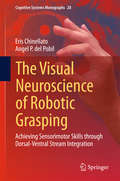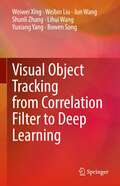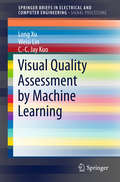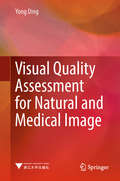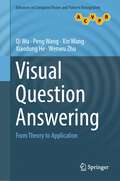- Table View
- List View
Visual Languages (Languages and Information Systems)
by Shi-Kuo Shi-Kuo ChangThis book is intended as both an introduction to the state-of-the-art in visual languages, as well as an exposition of the frontiers of research in advanced visual languages. It is for computer scientists, computer engi neers, information scientists, application programmers, and technical managers responsible for software development projects who are inter ested in the methodology and manifold applications of visual languages and visual programming. The contents of this book are drawn from invited papers, as well as selected papers from two workshops: the 1985 IEEE Workshop on Lan guages for Automation-Cognitive Aspects in Information Processing, which was held in Mallorca, Spain, June 28-30, 1985; and the 1984 IEEE Workshop on Visual Languages, which was held in Hiroshima, Japan, December 7-9, 1984. Panos Ligomenides and I organized the technical program of LFA '85, and Tadao Ichikawa and I organized the techni cal program of VL '84. Both workshops have now become successful annual events in their own right. The intersecting area of visual languages and visual programming especially has become a fascinating new research area. It is hoped that this book will focus the reader's attention on some of the interesting research issues as well as the potential for future applications. After reading this book, the reader will undoubtedly get an impression that visual languages and the concept of generalized icons can be studied fruitfully from many different perspectives, including computer graphics, formal language theory, educational methodology, cognitive psychology and visual design.
Visual Languages and Applications (Languages and Information Systems)
by Tadeo Ichikawa Erland Jungert Robert R. KorfhageThe interface between the user of a computer-based information system and the system itself has been evolving at a rapid rate. The use of a video screen, with its color and graphics capabilities, has been one factor in this evolution. The development of light pens, mice, and other screen image manipulation devices has been another. With these capabilities has come a natural desire to find more effective ways to make use of them. In particular, much work has gone into the development of interface systems that add visual elements such as icons and graphics to text. The desire to use these visual elements effectively in communication between the user and the system has resulted in a healthy competition of ideas and discussion of the principles governing the development and use of such elements. The present volume chronicles some of the more significant ideas that have recently been presented. The first volume in this series on the subject [Visual Languages (Chang, Ichikawa, and Ligomenides, eds. ), Plenum, 1986] covered work done in the early days of the field of visual languages. Here we represent ideas that have grown out of that early work, arranged in six sections: Theory, Design Systems, Visual Programming, Algorithm Animation, Simulation Animation, and Applications. I THEORY Fundamental to the concept of visual languages is the convIctIOn that diagrams and other visual representations can aid understanding and communication of ideas. We begin this volume with a chapter by Fanya S.
Visual Mathematics and Cyberlearning (Mathematics Education in the Digital Era)
by Dragana Martinovic, Viktor Freiman and Zekeriya KaradagThis first book in the series will describe the Net Generation as visual learners who thrive when surrounded with new technologies and whose needs can be met with the technological innovations. These new learners seek novel ways of studying, such as collaborating with peers, multitasking, as well as use of multimedia, the Internet, and other Information and Communication Technologies. Here we present mathematics as a contemporary subject that is engaging, exciting and enlightening in new ways. For example, in the distributed environment of cyber space, mathematics learners play games, watch presentations on YouTube, create Java applets of mathematics simulations and exchange thoughts over the Instant Messaging tool. How should mathematics education resonate with these learners and technological novelties that excite them?
Visual Media Processing Using Matlab Beginner's Guide
by George SiogkasWritten in a friendly, Beginner's Guide format, showing the user how to use the digital media aspects of Matlab (image, video, sound) in a practical, tutorial-based style.This is great for novice programmers in any language who would like to use Matlab as a tool for their image and video processing needs, and also comes in handy for photographers or video editors with even less programming experience wanting to find an all-in-one tool for their tasks.
Visual Methods for Digital Research: An Introduction
by Sabine Niederer Gabriele ColomboOver the last decade, images have become a key feature of digital culture; at the same time, they have made a mark on a wide range of research practices.Visual Methods for Digital Research is the first textbook to bring the fields of visual methods and digital research together. Presenting visual methods for digital and participatory research, the book covers both the application of existing digital methods for image research and new visual methodologies developed specifically for digital research. It encompasses various approaches to studying digital images, including the distant reading of image collections, the close reading of visual vernaculars of social media platforms, and participatory research with visual materials. Offering a theoretical framework illustrated with hands-on techniques, Sabine Niederer and Gabriele Colombo provide compelling examples for studying online images through visual and digital means, and discuss critical data practices such as data feminism and digital methods for social and cultural research.This textbook is an accessible and invaluable guide for students and researchers of digital humanities, social sciences, information and communication design, critical data visualization and digital visual culture.
The Visual Neuroscience of Robotic Grasping: Achieving Sensorimotor Skills through Dorsal-Ventral Stream Integration (Cognitive Systems Monographs #28)
by Eris Chinellato Angel P. del PobilThis book presents interdisciplinary research that pursues the mutual enrichment of neuroscience and robotics. Building on experimental work, and on the wealth of literature regarding the two cortical pathways of visual processing - the dorsal and ventral streams - we define and implement, computationally and on a real robot, a functional model of the brain areas involved in vision-based grasping actions.Grasping in robotics is largely an unsolved problem, and we show how the bio-inspired approach is successful in dealing with some fundamental issues of the task. Our robotic system can safely perform grasping actions on different unmodeled objects, denoting especially reliable visual and visuomotor skills.The computational model and the robotic experiments help in validating theories on the mechanisms employed by the brain areas more directly involved in grasping actions. This book offers new insights and research hypotheses regarding such mechanisms, especially for what concerns the interaction between the dorsal and ventral streams. Moreover, it helps in establishing a common research framework for neuroscientists and roboticists regarding research on brain functions.
Visual Object Recognition (Synthesis Lectures on Artificial Intelligence and Machine Learning)
by Kristen Thielscher Bastian ChernovaThe visual recognition problem is central to computer vision research. From robotics to information retrieval, many desired applications demand the ability to identify and localize categories, places, and objects. This tutorial overviews computer vision algorithms for visual object recognition and image classification. We introduce primary representations and learning approaches, with an emphasis on recent advances in the field. The target audience consists of researchers or students working in AI, robotics, or vision who would like to understand what methods and representations are available for these problems. This lecture summarizes what is and isn't possible to do reliably today, and overviews key concepts that could be employed in systems requiring visual categorization. Table of Contents: Introduction / Overview: Recognition of Specific Objects / Local Features: Detection and Description / Matching Local Features / Geometric Verification of Matched Features / Example Systems: Specific-Object Recognition / Overview: Recognition of Generic Object Categories / Representations for Object Categories / Generic Object Detection: Finding and Scoring Candidates / Learning Generic Object Category Models / Example Systems: Generic Object Recognition / Other Considerations and Current Challenges / Conclusions
Visual Object Tracking from Correlation Filter to Deep Learning
by Weiwei Xing Weibin Liu Jun Wang Shunli Zhang Lihui Wang Yuxiang Yang Bowen SongThe book focuses on visual object tracking systems and approaches based on correlation filter and deep learning. Both foundations and implementations have been addressed. The algorithm, system design and performance evaluation have been explored for three kinds of tracking methods including correlation filter based methods, correlation filter with deep feature based methods, and deep learning based methods. Firstly, context aware and multi-scale strategy are presented in correlation filter based trackers; then, long-short term correlation filter, context aware correlation filter and auxiliary relocation in SiamFC framework are proposed for combining correlation filter and deep learning in visual object tracking; finally, improvements in deep learning based trackers including Siamese network, GAN and reinforcement learning are designed. The goal of this book is to bring, in a timely fashion, the latest advances and developments in visual object tracking, especially correlation filter and deep learning based methods, which is particularly suited for readers who are interested in the research and technology innovation in visual object tracking and related fields.
The Visual Organization: Data Visualization, Big Data, and the Quest for Better Decisions (Wiley and SAS Business Series)
by Phil SimonThe era of Big Data as arrived, and most organizations are woefully unprepared. Slowly, many are discovering that stalwarts like Excel spreadsheets, KPIs, standard reports, and even traditional business intelligence tools aren't sufficient. These old standbys can't begin to handle today's increasing streams, volumes, and types of data. Amidst all of the chaos, though, a new type of organization is emerging. In The Visual Organization, award-winning author and technology expert Phil Simon looks at how an increasingly number of organizations are embracing new dataviz tools and, more important, a new mind-set based upon data discovery and exploration. Simon adroitly shows how Amazon, Apple, Facebook, Google, Twitter, and other tech heavyweights use powerful data visualization tools to garner fascinating insights into their businesses. But make no mistake: these companies are hardly alone. Organizations of all types, industries, sizes are representing their data in new and amazing ways. As a result, they are asking better questions and making better business decisions.Rife with real-world examples and case studies, The Visual Organization is a full-color tour-de-force.
The Visual Organization: Data Visualization, Big Data, and the Quest for Better Decisions (Wiley and SAS Business Series)
by Phil SimonThe era of Big Data as arrived, and most organizations are woefully unprepared. Slowly, many are discovering that stalwarts like Excel spreadsheets, KPIs, standard reports, and even traditional business intelligence tools aren't sufficient. These old standbys can't begin to handle today's increasing streams, volumes, and types of data. Amidst all of the chaos, though, a new type of organization is emerging. In The Visual Organization, award-winning author and technology expert Phil Simon looks at how an increasingly number of organizations are embracing new dataviz tools and, more important, a new mind-set based upon data discovery and exploration. Simon adroitly shows how Amazon, Apple, Facebook, Google, Twitter, and other tech heavyweights use powerful data visualization tools to garner fascinating insights into their businesses. But make no mistake: these companies are hardly alone. Organizations of all types, industries, sizes are representing their data in new and amazing ways. As a result, they are asking better questions and making better business decisions.Rife with real-world examples and case studies, The Visual Organization is a full-color tour-de-force.
Visual Pattern Discovery and Recognition (SpringerBriefs in Computer Science)
by Hongxing Wang Chaoqun Weng Junsong YuanThis book presents a systematic study of visual pattern discovery, from unsupervised to semi-supervised manner approaches, and from dealing with a single feature to multiple types of features. Furthermore, it discusses the potential applications of discovering visual patterns for visual data analytics, including visual search, object and scene recognition. It is intended as a reference book for advanced undergraduates or postgraduate students who are interested in visual data analytics, enabling them to quickly access the research world and acquire a systematic methodology rather than a few isolated techniques to analyze visual data with large variations. It is also inspiring for researchers working in computer vision and pattern recognition fields. Basic knowledge of linear algebra, computer vision and pattern recognition would be helpful to readers.
Visual Perception and Control of Underwater Robots
by Junzhi Yu Xingyu Chen Shihan KongVisual Perception and Control of Underwater Robots covers theories and applications from aquatic visual perception and underwater robotics. Within the framework of visual perception for underwater operations, image restoration, binocular measurement, and object detection are addressed. More specifically, the book includes adversarial critic learning for visual restoration, NSGA-II-based calibration for binocular measurement, prior knowledge refinement for object detection, analysis of temporal detection performance, as well as the effect of the aquatic data domain on object detection. With the aid of visual perception technologies, two up-to-date underwater robot systems are demonstrated. The first system focuses on underwater robotic operation for the task of object collection in the sea. The second is an untethered biomimetic robotic fish with a camera stabilizer, its control methods based on visual tracking. The authors provide a self-contained and comprehensive guide to understand underwater visual perception and control. Bridging the gap between theory and practice in underwater vision, the book features implementable algorithms, numerical examples, and tests, where codes are publicly available. Additionally, the mainstream technologies covered in the book include deep learning, adversarial learning, evolutionary computation, robust control, and underwater bionics. Researchers, senior undergraduate and graduate students, and engineers dealing with underwater visual perception and control will benefit from this work.
Visual Perception and Control of Underwater Robots
by Junzhi Yu Xingyu Chen Shihan KongVisual Perception and Control of Underwater Robots covers theories and applications from aquatic visual perception and underwater robotics. Within the framework of visual perception for underwater operations, image restoration, binocular measurement, and object detection are addressed. More specifically, the book includes adversarial critic learning for visual restoration, NSGA-II-based calibration for binocular measurement, prior knowledge refinement for object detection, analysis of temporal detection performance, as well as the effect of the aquatic data domain on object detection. With the aid of visual perception technologies, two up-to-date underwater robot systems are demonstrated. The first system focuses on underwater robotic operation for the task of object collection in the sea. The second is an untethered biomimetic robotic fish with a camera stabilizer, its control methods based on visual tracking. The authors provide a self-contained and comprehensive guide to understand underwater visual perception and control. Bridging the gap between theory and practice in underwater vision, the book features implementable algorithms, numerical examples, and tests, where codes are publicly available. Additionally, the mainstream technologies covered in the book include deep learning, adversarial learning, evolutionary computation, robust control, and underwater bionics. Researchers, senior undergraduate and graduate students, and engineers dealing with underwater visual perception and control will benefit from this work.
Visual Perception and Robotic Manipulation: 3D Object Recognition, Tracking and Hand-Eye Coordination (Springer Tracts in Advanced Robotics #26)
by Geoffrey Taylor Lindsay KleemanThis book moves toward the realization of domestic robots by presenting an integrated view of computer vision and robotics, covering fundamental topics including optimal sensor design, visual servo-ing, 3D object modelling and recognition, and multi-cue tracking, emphasizing robustness throughout. Covering theory and implementation, experimental results and comprehensive multimedia support including video clips, VRML data, C++ code and lecture slides, this book is a practical reference for roboticists and a valuable teaching resource.
Visual Perception for Humanoid Robots: Environmental Recognition and Localization, from Sensor Signals to Reliable 6D Poses (Cognitive Systems Monographs #38)
by David Israel González AguirreThis book provides an overview of model-based environmental visual perception for humanoid robots. The visual perception of a humanoid robot creates a bidirectional bridge connecting sensor signals with internal representations of environmental objects. The objective of such perception systems is to answer two fundamental questions: What & where is it? To answer these questions using a sensor-to-representation bridge, coordinated processes are conducted to extract and exploit cues matching robot’s mental representations to physical entities. These include sensor & actuator modeling, calibration, filtering, and feature extraction for state estimation. This book discusses the following topics in depth: • Active Sensing: Robust probabilistic methods for optimal, high dynamic range image acquisition are suitable for use with inexpensive cameras. This enables ideal sensing in arbitrary environmental conditions encountered in human-centric spaces. The book quantitatively shows the importance of equipping robots with dependable visual sensing. • Feature Extraction & Recognition: Parameter-free, edge extraction methods based on structural graphs enable the representation of geometric primitives effectively and efficiently. This is done by eccentricity segmentation providing excellent recognition even on noisy & low-resolution images. Stereoscopic vision, Euclidean metric and graph-shape descriptors are shown to be powerful mechanisms for difficult recognition tasks. • Global Self-Localization & Depth Uncertainty Learning: Simultaneous feature matching for global localization and 6D self-pose estimation are addressed by a novel geometric and probabilistic concept using intersection of Gaussian spheres. The path from intuition to the closed-form optimal solution determining the robot location is described, including a supervised learning method for uncertainty depth modeling based on extensive ground-truth training data from a motion capture system.The methods and experiments are presented in self-contained chapters with comparisons and the state of the art. The algorithms were implemented and empirically evaluated on two humanoid robots: ARMAR III-A & B. The excellent robustness, performance and derived results received an award at the IEEE conference on humanoid robots and the contributions have been utilized for numerous visual manipulation tasks with demonstration at distinguished venues such as ICRA, CeBIT, IAS, and Automatica.
Visual Perception for Manipulation and Imitation in Humanoid Robots (Cognitive Systems Monographs #4)
by Pedram AzadVisual Perception from a Computer Graphics Perspective
by William Thompson Roland Fleming Sarah Creem-Regehr Jeanine Kelly StefanucciThis book provides an introduction to human visual perception suitable for readers studying or working in the fields of computer graphics and visualization, cognitive science, and visual neuroscience. It focuses on how computer graphics images are generated, rather than solely on the organization of the visual system itself; therefore, the text pro
Visual Privacy Management: Design and Applications of a Privacy-Enabling Platform (Lecture Notes in Computer Science #12030)
by Haralambos Mouratidis Paolo Giorgini Mattia Salnitri Jan Jürgens Loredana ManciniPrivacy is a burden for most organizations, the more complex and wider an organization is, the harder to manage and enforce privacy is.GDPR and other regulations on privacy impose strict constraints that must be coherently enforced, considering also privacy needs of organization and their users. Furthermore, organizations should allow their users to express their privacy needs easily, even when the process that manages users' data is complex and involves multiple organizations.Many research work consider the problem using simplistic examples, with solutions proposed that never actually touch pragmatic problems of real, large organizations, with thousands of users and terabytes of personal and sensitive data.This book faces the privacy management problem targeting actual large organizations, such as public administrations, including stakeholders in the process of definition of the solution and evaluating the results with its actual integration in four large organizations. The contribution of this book is twofold: a privacy platform that can be customized and used to manage privacy in large organizations; and the process for the design of such a platform, from a state-of-the-art survey on privacy regulations, through the definition of its requirements, its design and its architecture, until the evaluation of the platform.
Visual Quality Assessment by Machine Learning (SpringerBriefs in Electrical and Computer Engineering)
by Long Xu Weisi Lin C.-C. Jay KuoThe book encompasses the state-of-the-art visual quality assessment (VQA) and learning based visual quality assessment (LB-VQA) by providing a comprehensive overview of the existing relevant methods. It delivers the readers the basic knowledge, systematic overview and new development of VQA. It also encompasses the preliminary knowledge of Machine Learning (ML) to VQA tasks and newly developed ML techniques for the purpose. Hence, firstly, it is particularly helpful to the beginner-readers (including research students) to enter into VQA field in general and LB-VQA one in particular. Secondly, new development in VQA and LB-VQA particularly are detailed in this book, which will give peer researchers and engineers new insights in VQA.
Visual Quality Assessment for Natural and Medical Image
by Yong DingImage quality assessment (IQA) is an essential technique in the design of modern, large-scale image and video processing systems. This book introduces and discusses in detail topics related to IQA, including the basic principles of subjective and objective experiments, biological evidence for image quality perception, and recent research developments. In line with recent trends in imaging techniques and to explain the application-specific utilization, it particularly focuses on IQA for stereoscopic (3D) images and medical images, rather than on planar (2D) natural images. In addition, a wealth of vivid, specific figures and formulas help readers deepen their understanding of fundamental and new applications for image quality assessment technology. This book is suitable for researchers, clinicians and engineers as well as students working in related disciplines, including imaging, displaying, image processing, and storage and transmission. By reviewing and presenting the latest advances, and new trends and challenges in the field, it benefits researchers and industrial R&D engineers seeking to implement image quality assessment systems for specific applications or design/optimize image/video processing algorithms.
Visual Quantum Mechanics: Selected Topics with Computer-Generated Animations of Quantum-Mechanical Phenomena
by Bernd Thaller"Visual Quantum Mechanics" uses the computer-generated animations found on the accompanying material on Springer Extras to introduce, motivate, and illustrate the concepts explained in the book. While there are other books on the market that use Mathematica or Maple to teach quantum mechanics, this book differs in that the text describes the mathematical and physical ideas of quantum mechanics in the conventional manner. There is no special emphasis on computational physics or requirement that the reader know a symbolic computation package. Despite the presentation of rather advanced topics, the book requires only calculus, making complicated results more comprehensible via visualization. The material on Springer Extras provides easy access to more than 300 digital movies, animated illustrations, and interactive pictures. This book along with its extra online materials forms a complete introductory course on spinless particles in one and two dimensions.
Visual Question Answering: From Theory to Application (Advances in Computer Vision and Pattern Recognition)
by Qi Wu Peng Wang Xin Wang Xiaodong He Wenwu ZhuVisual Question Answering (VQA) usually combines visual inputs like image and video with a natural language question concerning the input and generates a natural language answer as the output. This is by nature a multi-disciplinary research problem, involving computer vision (CV), natural language processing (NLP), knowledge representation and reasoning (KR), etc. Further, VQA is an ambitious undertaking, as it must overcome the challenges of general image understanding and the question-answering task, as well as the difficulties entailed by using large-scale databases with mixed-quality inputs. However, with the advent of deep learning (DL) and driven by the existence of advanced techniques in both CV and NLP and the availability of relevant large-scale datasets, we have recently seen enormous strides in VQA, with more systems and promising results emerging. This book provides a comprehensive overview of VQA, covering fundamental theories, models, datasets, and promising future directions. Given its scope, it can be used as a textbook on computer vision and natural language processing, especially for researchers and students in the area of visual question answering. It also highlights the key models used in VQA.
Visual Representations and Interpretations
by Ray Paton Irene NeilsenThe value of multi-disciplinary research and the exchange of ideas and methods across traditional discipline boundaries are well recognised. Indeed, it could be justifiably argued that many of the advances in science and engineering take place because the ideas, methods and the tools of thought from one discipline become re applied in others. Sadly, it is also the case that many subject areas develop specialised vocabularies and concepts and can consequently approach more general problems in fairly narrow, subject-specific ways. Consequently barriers develop between disciplines that prevent the free flow of ideas and the collaborations that on Visual Representations could often bring success. VRI'98, a workshop focused & Interpretations, was intended to break down such barriers. The workshop was held in the Foresight Conference Centre, which occupies part of the former Liverpool Royal Infirmary, a Grade 2 listed building, which has been recently restored. The building combines a majestic architecture with the latest in new conference facilities and technologies and thus provided a very suitable setting for a workshop aimed at bringing the Arts and the Sciences together. of the workshop was to promote inter-disciplinary awareness across The main aim a range of disciplines where visual representations and interpretations are exploited. Contributions to the workshop were therefore invited from researchers who are actively investigating visual representations and interpretations: - artists, architects, biologists, chemists, clinicians, cognitive scientists, computer scientists, educationalists, engineers, graphic designers, linguists, mathematicians, philosophers, physicists, psychologists and social scientists.
Visual Research Methods in Educational Research
by Barbara Pini Julianne MossHave you noticed there is a burgeoning take up of visual research in education? Are you considering using visual research as part of your next research project or revitalising your research methods course? For researchers who are new to the field of VRMs in education there is little critical literature on the subject. This book addresses the gap in the literature and brings together some of the leading educational researchers engaging and reflecting on the visual from Australia, the UK and Canada. Encapsulated in a single volume, this book sets out theoretically grounded discussions of the possibilities and challenges of the approach for educational researchers around four key themes: images of schooling, performing pedagogy, power and representation and ethical issues in educational research.






